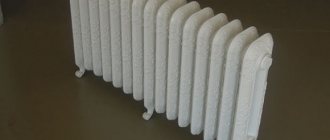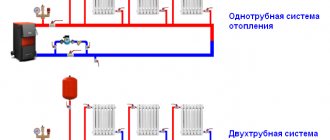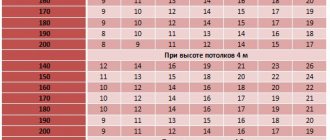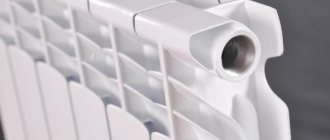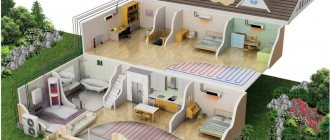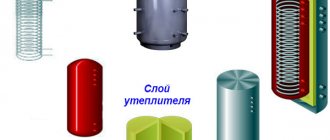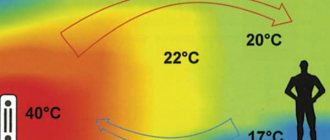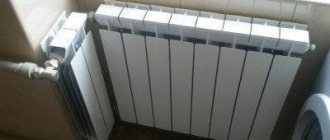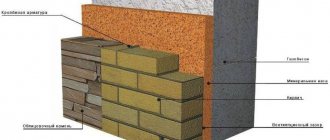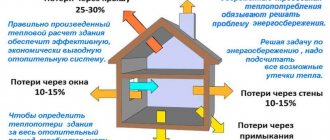Despite the emergence of innovative developments, the familiar heating system using radiators has not been forgotten: it is still just as popular. The reasons for this demand are its efficiency and reliability. However, in this case, an accurate calculation is required before installation. A lack of heat generated will lead to cold in the house in winter; its excess will require frequent ventilation and high heating costs. To avoid such consequences, it is better to find out in advance how many squares 1 radiator section is designed for. There are several ways to get the desired value - the right number of them. Some of them are approximate, others can be called quite accurate.
What types of radiators are there?
Before finding out how many squares 1 radiator section is designed for, you need to get acquainted with the types of these products, since the final result largely depends on their properties. The range now includes aluminum, bimetallic, steel and traditional cast iron batteries.
Aluminum
These batteries appeared recently, but their “young age” did not prevent them from immediately gaining popularity. New products are relatively inexpensive, they look modern and elegant. They also have no problems with heat transfer. The best models are able to withstand pressure of 15 atmospheres and higher with honor; high water temperatures (up to 100°) are also not scary for them.
The heat output of one section can reach 200 W. The list of advantages includes light weight, since 1 section of the radiator “tightens” a maximum of 2 kg, and its capacity is small - 500 ml, no more. There are two options available in stores - one-piece products that are designed for a certain power, and stacked batteries that allow you to change the number of sections.
“Newbies” are not without their shortcomings. Some models are very demanding on the quality of the coolant, as they are susceptible to oxygen corrosion. Non-removable structures may leak and cannot be repaired, so replacement will be required. The best option is products made using anodizing. The oxide film reliably protects them from corrosion.
Bimetallic
These modern radiators can be considered universal: in terms of reliability they compete with cast iron products, and in terms of heat transfer quality - with aluminum “heat exchangers”. The prefix "bi" means the presence of two metals - steel and aluminum. 1 section of the radiator consists of 2 horizontal collectors connected by a vertical channel.
The pipes are made of metal coated with a polymer coating. The outer shell is aluminum, which does not come into contact with the coolant, so it is not afraid of corrosion. Thanks to this combination, radiators have no weak points: they guarantee high strength, wear resistance and excellent thermal characteristics.
The batteries are not afraid of high temperatures and water hammer. These station wagons are suitable for both multi-apartment and private houses. The ideal condition for them is high pressure in the central system. If we talk about disadvantages, then the only disadvantage of any high-quality product is only one: it is a high price when compared with the cost of other competitors.
Steel
These structures have a low price, low weight, and are quite easy to install. Despite all the advantages, attractive appearance, variety of design solutions, steel batteries still could not become worthy rivals to devices made from other materials. The reason is their characteristics.
Thin walls heat up very quickly, but cool down just as quickly. With water hammer, a more serious problem is possible - the appearance of a leak. Another disadvantage is corrosion of those models that are not protected by a special coating. The service life of such products is depressing: manufacturers provide a small guarantee.
Steel radiators, as a rule, are not divided into sections; they are a solid structure. In this case, when choosing, they are guided by the passport specific thermal power, taking into account the footage of the room and its features. There are exceptions - tubular batteries, but they are not very practical: the number of sections can only be changed during production, to order.
Cast iron
Everyone has been familiar with these batteries since childhood, because such structures used to be installed everywhere. If you compare those old batteries with modern products, the difference in appearance is enormous, but the “hulks” served faithfully for more than one generation. 1 section of the radiator had good heat dissipation - about 160 W.
Now the range of cast iron batteries has expanded significantly. Some models are not only in no way inferior in beauty to their lighter and more elegant competitors, but sometimes even surpass them. The external transformation did not in any way affect the characteristics of the models. They also retain heat for a long time and have high heat output.
Correct installation allows you not to worry about water hammer and temperature changes. Thick cast iron perfectly resists corrosion and attacks from abrasive coolant particles, so it can be used in any heating system. Disadvantages - the relative fragility of the metal, the complexity of installation due to the massiveness of the products, heavy weight, requiring durable interior partitions.
Calculation of heating radiators by area
The easiest way. Calculate the amount of heat required for heating, based on the area of the room in which the radiators will be installed. You know the area of each room, and the heat requirement can be determined according to SNiP building codes:
- for an average climate zone, heating 1 m2 of living space requires 60-100 W;
- for areas above 60° 150-200W is required.
Based on these standards, you can calculate how much heat your room will require. If the apartment/house is located in the middle climate zone, heating an area of 16 m2 will require 1600 W of heat (16*100=1600). Since the standards are average, and the weather is not constant, we believe that 100W is required. Although, if you live in the south of the middle climate zone and your winters are mild, count 60W.
Calculation of heating radiators can be done according to SNiP standards
A power reserve in heating is needed, but not very large: with an increase in the amount of power required, the number of radiators increases. And the more radiators, the more coolant in the system. If for those who are connected to central heating this is not critical, then for those who have or are planning individual heating, a large volume of the system means large (extra) costs for heating the coolant and greater inertia of the system (the set temperature is less accurately maintained). And a logical question arises: “Why pay more?”
Having calculated the room's heat requirement, we can find out how many sections are required. Each heating device can produce a certain amount of heat, which is indicated in the passport. Take the found heat requirement and divide it by the radiator power. The result is the required number of sections to make up for losses.
Let's count the number of radiators for the same room. We determined that 1600W needed to be allocated. Let the power of one section be 170W. It turns out 1600/170 = 9.411 pieces. You can round up or down at your discretion. You can turn it into a smaller one, for example, in the kitchen - there are plenty of additional heat sources there, and a larger one - better in a room with a balcony, a large window or in a corner room.
The system is simple, but the disadvantages are obvious: ceiling heights can be different, wall material, windows, insulation and a number of other factors are not taken into account. So the calculation of the number of sections of heating radiators according to SNiP is approximate. For an accurate result, you need to make adjustments.
“Calculation taking into account” the characteristics of the room
This is the most complex method, but it will give almost accurate figures due to the large number of different coefficients. They do not relate to the heating system, but only to the features of the room, to the methods of installing the batteries. The same formula is used:
To obtain the required heat transfer, which will then have to be divided by the thermal power of one section, the footage (not volume!) of the room is first multiplied by the average power rate for 1 m2. It does not depend on the region and is 100 W. Then the result is multiplied in turn with coefficients A, B, C, D, E, F, G, H, I and J.
“A” is the number of external walls of the room
To a greater extent, heat loss strongly depends on their quantity:
- there is only one outer wall: 1,0;
- two external walls - 1,2;
- external walls - three: 1,3;
- four walls - 1,4.
“B” - room orientation
A minimum of heat is retained in rooms with windows facing where there is always little sunlight: to the north or east, where the sun’s rays are “noted” only in the morning:
- windows face east or north - 1,1;
- the room is located on the west or south side - 1,0.
“C” - degree of insulation
High-quality thermal insulation gives a chance to retain heat in the room as much as possible:
- 2-brick masonry or insulated external walls - 1,0;
- no insulation on the outside - 1,27;
- very high level of insulation (if thermal calculations have been carried out) - 0,85.
"D" - climate in the region
SNiP also takes these conditions into account; without taking them into account, no capital construction is possible. Here they use the average temperature of December, its coldest ten-day period. This data must be obtained from the hydrometeorological service of the city (district):
- up to -10° — 0,7;
- up to -15° — 0,9;
- not lower than -20° — 1,1;
- from -25° to -35° — 1,3;
- from -35° or below - 1,5.
"E" - ceiling height
As already noted, both SNiP standards (from 60 to 200 W per 1 m2) and the average value (100 W) used in this case imply a standard ceiling height of 2700 mm. If they do not “reach” this figure, then they choose a coefficient of 1.0 . When the height exceeds it, then another is taken for multiplication:
- 1,05, if the height is in the range of 2800-3000 mm;
- 1,1 for 3100-3500 mm;
- 1,15 for 3600-4000 mm;
- 1,2, if the ceiling height is more than 4100 mm.
"F" - the room located above
Since rising warm air more readily escapes through the ceiling of a room, in this case the upper floor is of great importance. These coefficients look like this:
- above the attic or other unheated room - 1,0;
- insulated attic and roof - 0,9;
- heated room - 0,8.
“G” – quality of window structures
Different plastic windows have different characteristics. Ordinary window designs stand apart, greatly increasing the coefficient:
- old style wooden frames with double glazing - 1,27;
- single-chamber double-glazed window with two glasses - 1,0;
- double-glazed window or single-chamber, but with argan coating, - 0,85.
“H” - room glazing area
Regardless of the quality of window structures, more heat loss occurs due to the impressive window area. This coefficient depends on the ratio of the area of window openings and the total footage of the room:
- less than 0.1 — 0,8;
- from 0.11 to 0.2 - 0,9;
- 0,31-0,4 — 1,1;
- from 0.41 to 0.5 - 1,2.
“I” - radiator connection diagram
Heating efficiency depends on how the batteries are connected to the pipes - both supply and return. The best option is a diagonal connection: the first from above, the second from below. It (indicated by the letter A in the figure) corresponds to the coefficient 1,0.
- B - 1,03;
- IN - 1,13;
- G - 1,25;
- D, E - 1,28.
Calculation example
If you calculate how many sections of an aluminum radiator are needed for a room with an area of 20 m2 at a rate of 100 W/m2, then adjustment coefficients for heat loss should also be made:
- each window adds 0.2 kW to the indicator;
- the door “costs” 0.1 kW.
If it is assumed that the radiator will be placed under the window sill, then the correction factor will be 1.04, and the formula itself will look like this:
Q = (20 x 100 + 0.2 + 0.1) x 1.3 x 1.04 / 72 = 37.56
Where:
- the first indicator is the area of the room;
- the second is the standard number of W per m2;
- the third and fourth indicate that the room has one window and one door;
- the next indicator is the heat transfer level of the aluminum radiator in kW;
- the sixth is a correction factor regarding the location of the battery.
Everything should be divided by the heat output of one heater fin. It can be determined from the table from the manufacturer, which shows the heating coefficients of the carrier in relation to the power of the device. The average for one edge is 180 W, and the adjustment is 0.4. Thus, multiplying these numbers, it turns out that one section produces 72 W when heating water to +60 degrees.
Since rounding is done upward, the maximum number of sections in an aluminum radiator specifically for this room will be 38 fins. To improve the performance of the structure, it should be divided into 2 parts of 19 ribs each.
Methods for assessing heat transfer
Before purchasing heating batteries, we will consider ways to calculate the number of their elements.
The first method is based on the area of the room. Construction standards (SNiP) state that for normal heating 1 sq. m. requires 100 W. thermal power. By measuring the length and width of the room, and multiplying these two values, we get the area of the room (S).
To calculate the total power (Q), we substitute our value into the formula, Q=S*100 W. The passport for heating radiators indicates the heat transfer of one element (q1). Thanks to this information, we will know the required number. To do this, divide Q by q1.
The second method is more accurate. It should also be used with a ceiling height of 3 meters or more. Its difference lies in measuring the volume of the room. The area of the room is already known, let's measure the height of the ceiling, then multiply these values. We substitute the resulting volume value (V) into the formula Q=V*41 W.
According to building codes, 1 cubic meter. m. should be heated by 41 W. thermal power. Now let's find the ratio of Q to q1, obtaining the total number of radiator nodes.
Let's sum up the interim results and bring out the data that will be needed for all types of calculations.
- Wall length;
- Wall width;
- Ceiling height;
- Power standards for heating a unit of area or volume of a room. They are given above;
- Minimum heat transfer of the radiator element. It must be indicated in the passport;
- Wall thickness;
- Number of window openings.
How to calculate radiator sections by room volume
This calculation takes into account not only the area, but also the height of the ceilings, because all the air in the room needs to be heated. So this approach is justified. And in this case the technique is similar. We determine the volume of the room, and then, according to the standards, we find out how much heat is needed to heat it:
- in a panel house, heating a cubic meter of air requires 41 W;
- in a brick house per m3 - 34W.
You need to heat the entire volume of air in the room, so it is more correct to calculate the number of radiators by volume
Let's calculate everything for the same room with an area of 16 m2 and compare the results. Let the ceiling height be 2.7m. Volume: 16*2.7=43.2m3.
Next we will calculate for options in a panel and brick house:
- In a panel house. The heat required for heating is 43.2m3*41V=1771.2W. If we take all the same sections with a power of 170 W, we get: 1771 W/170 W = 10,418 pcs (11 pcs).
- In a brick house. Heat needed is 43.2 m3*34W=1468.8W. We count the radiators: 1468.8W/170W=8.64pcs (9pcs).
As you can see, the difference is quite large: 11 pieces and 9 pieces. Moreover, when calculating by area, we got the average value (if rounded in the same direction) - 10 pcs.
